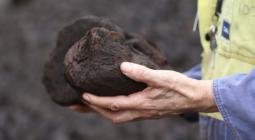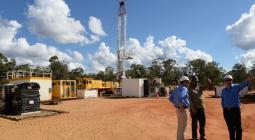Call for energy giant AGL to face criminal charges over coal ash spill.

Conservationists allege company has breached its environmental licence 52 times at its NSW Bayswater power station site in the past five years
Australia’s biggest greenhouse gas emitter, AGL, will pay a $1m penalty for a coal ash spill at a creek in the Hunter region of New South Wales, but environmentalists say the company should have faced criminal prosecution.
The incident occurred at the Bayswater power station near Muswellbrook in September 2019 when a pipeline transporting fly ash – a waste product from burning coal – burst, causing 1,440 cubic metres of hazardous slurry to leak into the dry bed of Bayswater Creek.
The company has agreed to pay $1m, comprising at least $500,000 for rectification works and a further $500,000 for community environment projects, in an agreement with the NSW environmental regulator, the Environment Protection Authority.
The fine is a record for NSW, but conservationists say the regulator should have commenced criminal proceedings and are calling for a state parliamentary inquiry to recommend tougher regulation of coal ash.
Jocelyn McGarity, a lawyer for Environmental Justice Australia, alleged AGL had recorded 52 breaches of its environmental licence at the Bayswater site in the past five years, including another instance where an ash pipeline began to leak.
She said the community accepted that the regulator faced a complex task in deciding how it responded to environmental incidents but “people are questioning whether this response is an appropriate one”.
“It really means that AGL has avoided criminal prosecution again, which means this doesn’t go on AGL’s record as a criminal offence as it would have had the EPA prosecuted and been successful in that prosecution,” McGarity said.
“In this case, AGL’s compliance history suggests stronger action should have been taken.”
McGarity said she hoped the parliamentary inquiry into the cost of remediating sites containing coal ash waste would make recommendations for “comprehensive” clean-ups of existing coal ash dumps.
Chris Gambian, the chief executive of the Nature Conservation Council of NSW, said the EPA’s response to the breach should have been tougher.
“AGL has gotten off very lightly considering how serious this pollution event was,” he said. “The EPA should have thrown the book at AGL and prosecuted the company through the courts.
“There is a very real risk that the $500,000 AGL has agreed to pay for environmental restoration will just end up being a public relations exercise to greenwash its reputation in the local community.”
An AGL spokeswoman said the agreement it reached with the regulator was “designed to improve environmental performance at AGL Macquarie and within the energy industry”.
She said the $500,000 for environmental projects would be spent on projects that benefited the local community.
“AGL takes our environmental obligations seriously and are committed to working with the NSW EPA to ensure that these initiatives are successfully implemented, and the subsequent environmental improvement outcomes are achieved,” she said.
Adam Gilligan, the EPA’s director of regulatory operations, said the financial undertaking would be put to good use and was a good environmental result.
“This outcome should also serve as a reminder to industry that environmental incidents such as this can come at a significant cost, and preventing such incidents makes good business sense.”
16 December 2020
The Guardian




